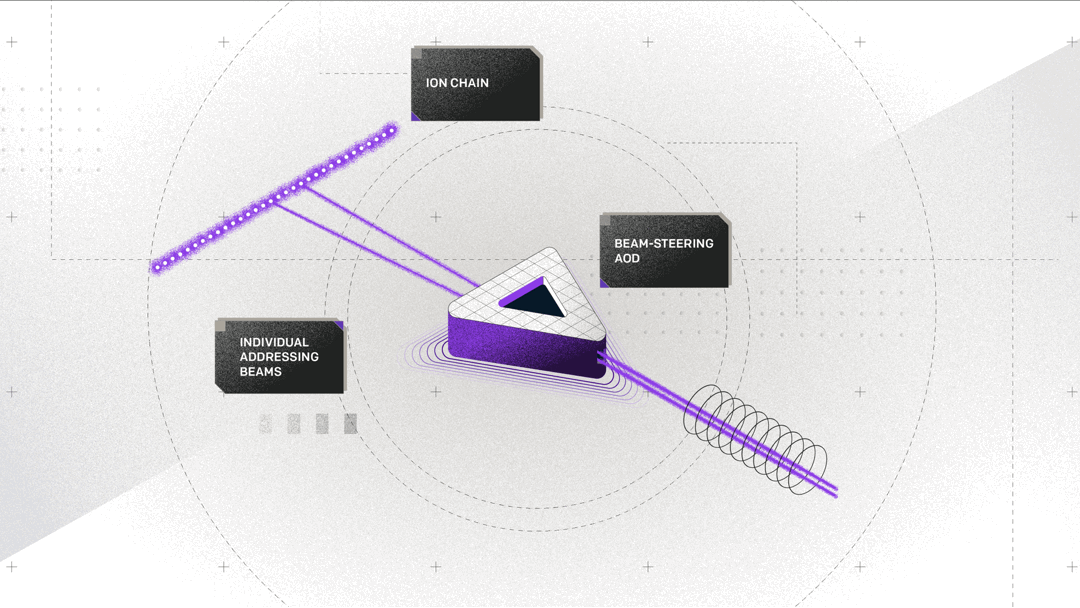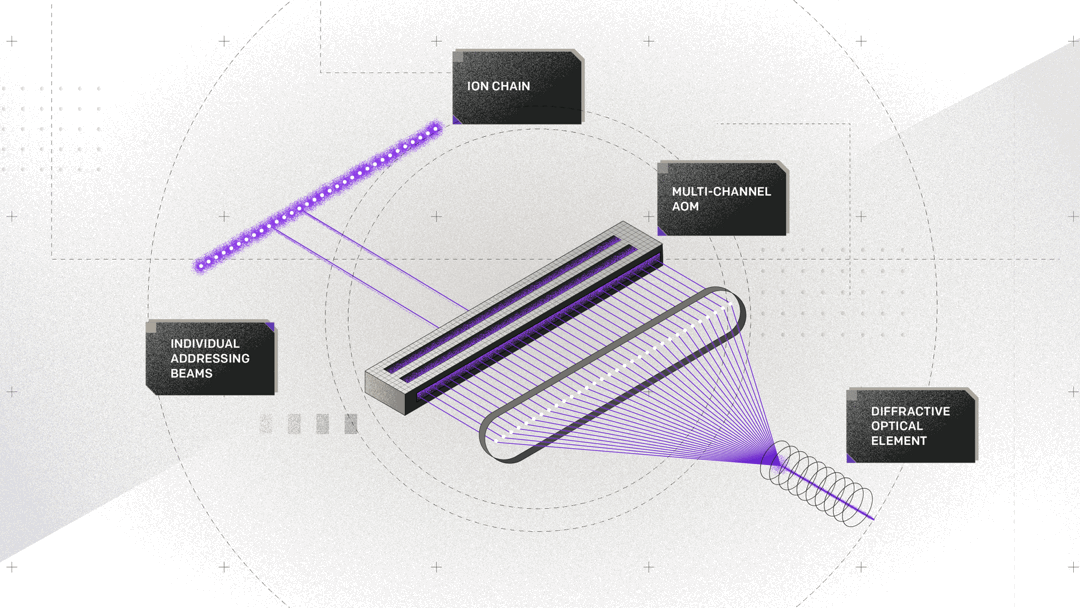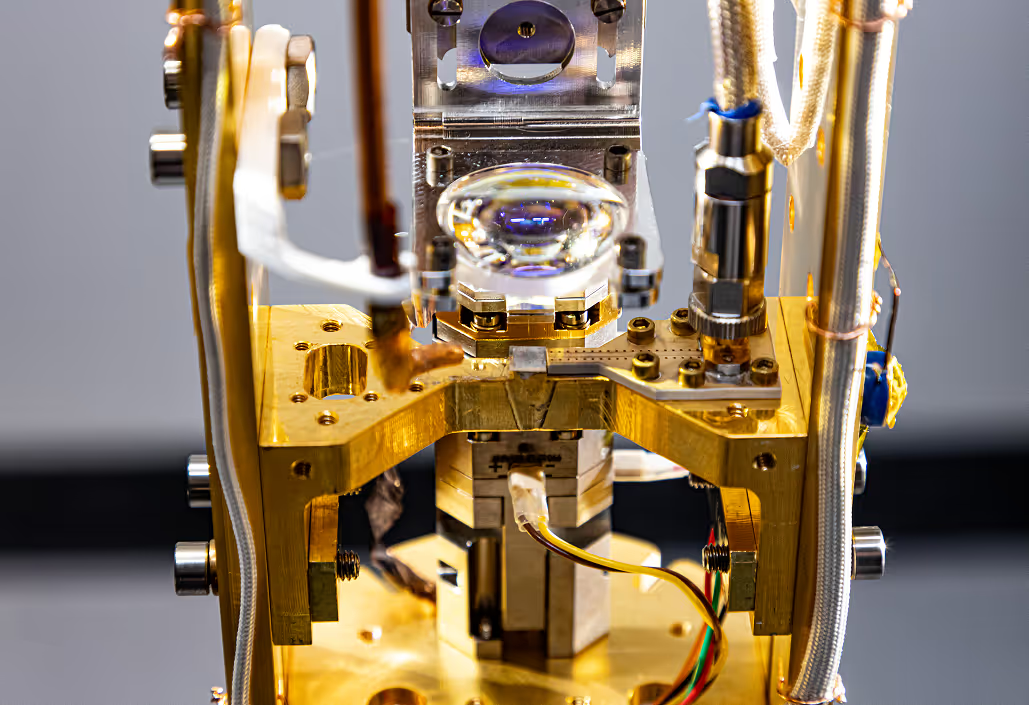Introducing IonQ Forte
IonQ Forte is the world's first software-configurable quantum computer. It uses ytterbium ions and integrates highly specialized acousto-optic deflectors (AODs) to direct laser beams at individual qubits in the ion chain to apply logic gates among the qubits. This approach provides unprecedented precision and stability to the laser beams contributing to both higher fidelity and reliability by minimizing noise and unintended residual light on neighboring qubits.
.jpeg)
Compared to our previous systems, IonQ Forte decouples the qubit arrangement in space from a fixed optical addressing system, leading to higher performance, the support of more qubits, and more software-driven flexibility. In fact, our goal is to deliver quantum computers whose architecture is fully controlled through software, from the number of qubits to the entangling gates, connectivity between qubits, error correction, and ultimately the entire system performance as measured by the Algorithmic Qubit (#AQ) metric.
IonQ Forte, designed with a capacity of up to 32 qubits like IonQ Aria and further expandable in software, represents a major step in that direction. Once fully characterized (tested and measured), we expect that it will demonstrate superior #AQ results and allow customers to run deeper quantum circuits than ever before. We anticipate that IonQ Forte will be made broadly available in early 2023, with earlier access expected to be provided to select developers, partners, and researchers in 2022 to work alongside IonQ’s scientists in evaluating the full potential of this powerful quantum system.
In this blog post, we will bring you into our development process for IonQ Forte, and share our thinking, early results, and plans for the future.
Software-Configurable Quantum Computer
Atomic ions, meaning individual atoms with one missing electron, are an excellent resource for storing quantum bits. Using highly tuned electromagnetic fields, dozens of ions can be trapped in a long linear chain (a single core) ready for further manipulation. With the aid of precision lasers, these trapped ions can then be entangled using high-quality two-qubit quantum gates between any pair of qubits in the chain. This approach is the core technology behind IonQ’s quantum computers. We believe that the all-to-all connectivity within a core, enabled by the long-range Coulomb interaction (the force between two stationary, electrically charged particles) is a significant and unique advantage of IonQ’s processor architecture. It enables highly efficient realizations of quantum algorithms with arbitrary internal structure.
One fascinating feature of this system is that crucial performance characteristics of the quantum computer, such as “How many qubits does your computer have?” or “Which qubit is connected to which other qubits?”, are not frozen into the design of the system. Unlike a computer chip where the transistors and wires are set permanently onto the chip at the time of manufacturing, we can load different numbers of qubits into our system and “wire them up” by designing laser control signals to enable entangling gates among them. In a way, the key features of the quantum computer can be configured through software, after the system is fully manufactured.
The introduction of AODs in IonQ Forte is a major step forward in our long-standing vision of a “Software-Configurable Quantum Computer” architecture (referred to as “Software-Defined Quantum Computer” in IonQ’s recently issued patent1 ). IonQ’s system evolution has consistently pursued this trend, and the transition from fixed beam multi-channel acousto-optic modulators (AOMs) to flexible AODs eliminates the precise alignment of our trapped ion qubits to fixed laser beams in space. This can now be done in software. Moreover, the system’s maximum capacity no longer depends on the number of beam channels in the hardware, as is the case in IonQ Aria, which is capped at 32 channels.
AOD Technology
AODs are common in beam-scanning applications, where the deflection angle of a beam is controlled by a radio frequency (RF) signal applied through software. The novel use of these devices in ion traps for quantum computers has several key advantages compared to the multi-channel AOMs used in our previous systems2 . Using this technique, IonQ Forte’s laser control system can address over 40 individual ion qubits within the chain. It also uses the laser power more efficiently, since it is not “wasting” laser power to provide inputs to channels that are not being used to run gates. The biggest advantage of AODs, however, is the ability to precisely and individually adjust the laser beam position for each ion within the chain, thereby overcoming small variations in ion distances that naturally occur in a long chain of trapped ions. This customized alignment of the addressing beams is the most significant technological advancement in this new generation and the most impactful contributor to IonQ Forte’s step function improvement in performance.


So, Meet IonQ Forte, in its First Configuration!
IonQ Forte is initially equipped with 32 detection channels, which makes simultaneous readout of 32 qubits straightforward. We started operating IonQ Forte with a 35-ion chain configuration, of which we operate on 31 of them as qubits (it turns out that having a single ion in the center of the chain makes optical alignment easier in the early development stages of a new system). This configuration results in a high-performance 31 qubit quantum computer with all-to-all connectivity (Figure 3), providing a versatile system designed to execute some of the most complex quantum algorithms to be run on a physical quantum computer yet.
.png)
Sneak Peak at Early Performance of IonQ Forte
As often iterated in this blog in the past, not all qubits in quantum computing are the same. For the last two years, IonQ has been refining and advocating for an objective benchmark for quantum computing performance called Algorithmic Qubits(#AQ) . Higher #AQ means users can run more complex quantum computing jobs, and arises from higher fidelity gate operations and better quantum processor architecture. Here, we share our early device-level performance characteristics of IonQ Forte that will impact #AQ.
Using the AOD technology, we have achieved excellent addressing specificity of the target qubit compared to other qubits in the chain. When experiencing imperfections in addressing ions with laser beams, the resulting artifacts can be characterized as “crosstalk,” where the laser beam targeting one of the qubits might accidentally affect its neighboring qubits. AOD fine-tuning and customization can greatly alleviate this artifact and produce far more stable and accurate gates. We measured the maximum residual action on any other (neighboring) qubit to be below 1.1% of the action on the target qubit. With the risk of getting even more technical, the impact of the spillover is further reduced by realizing gates using compensated pulse sequences that suppress the residual action on any of the neighboring qubits.
We characterized single qubit gates across all 31 qubits using randomized benchmarking and obtained an average single qubit gate infidelity of 0.04% or 4‱ — ‱ denotes parts per ten thousand or 0.01%. State preparation and measurement error for each qubit is below 0.6%.
In a fully connected register of 31 qubits, there are 465 unique qubit pairs between which entangling gates can be performed. We characterized all 465 possible two-qubit gates using a straightforward method that examines the gate performance statistics in aggregate. In this method, we used each two-qubit gate pair to generate a “maximally entangled state” between the two target qubits and measured the fidelity of the resulting state. When the two-qubit gate is repeated four times (back-to-back), the qubits are returned to the initial state. Therefore, by concatenating (4n+1) two-qubit gates, we can re-create the same maximally entangled state again. By measuring the fidelity of the resulting maximally entangled state as a function of the number of concatenated entangling gates, we can measure the incremental error contributed by each gate3 . We measured the fidelity of the maximally entangled state generated by concatenating up to 21 entangling gates (depth of 21), for all 465 possible pairs of qubits. With this technique, we got an average infidelity of the resulting entangled state of 36±27‱ , contributed by each entangling gate (corresponding to about 99.6% fidelity contribution). Figure 4 shows the distribution of average infidelity contributed to the final entangled state by each gate, measured over all 465 possible qubit pairs in the system. We note that the infidelity contribution is quite uniform across the qubit pairs.
.png)
Understanding the Error Characteristics
Now that we have assessed the overall quality and uniformity of our two-qubit gates, we can try to understand and improve them in greater depth. For the careful characterization of individual single and two-qubit gates, we used Gate Set Tomography (GST)4 . GST is a statistically rigorous qubit performance evaluation method developed by the Quantum Performance Laboratory at Sandia National Laboratories. Through GST, we gain detailed debugging information about the individual quantum operations of our system, at the expense of a larger number of required circuits.
We executed 2-qubit GST sequences up to a depth of 32 gates for two particular ions (10 and 21) to explore the single and two-qubit gates in depth. According to the GST analysis, IonQ Forte achieved an initial average gate infidelity of single-qubit gates between 3‱ and 7‱ corresponding to single-qubit gate fidelities between 99.97% and 99.93%. The initial average gate infidelity for the entangling two-qubit gate was measured at 57‱ (corresponding to 99.43% fidelity).
In addition to gate performance metrics, GST also provides an assessment of the dominant error contributions. For all gates, GST indicates that the errors in IonQ Forte are dominated by coherent errors (arising from imprecisions in the control pulses, such as the fluctuations in laser power used to drive the gates and miscalibration of light shifts) and not incoherent errors (due to fundamental physical limitations such as photon scattering, which tends to completely destroy the qubit). Figure 5 shows the data, for those interested in the technical details of this analysis. Note that the average gate fidelity as measured with GST (99.43%) is lower than the fidelity contribution per gate to the final entangled state (99.76%) for this qubit pair. This is not surprising, as certain coherent errors in the gate can cancel out as more gates are concatenated, leading to increased fidelity of the final entangled state.
The coherent errors we observe in the system can be reduced by improving the calibration, and stability of control laser beams, or applying advanced quantum control techniques. Guided by the GST analysis results, we expect to eliminate most of these errors in the upcoming performance improvement phase of system verification, thereby raising the gate fidelities further. We expect these improvements will lead to higher #AQ performance for IonQ Forte, exceeding even our best commercial system, IonQ Aria.
.png)
IonQ Forte System Performance
IonQ Forte’s computational power will be measured by Algorithmic Qubits(#AQ) , based on executing quantum algorithms of practical interest - useful algorithms with real-world applications. Next, the team will take IonQ Forte through its paces, measuring every single algorithm in the #AQ benchmarking suite towards our 2022 technology roadmap goal of #AQ 25. The errors in our gates are dominated by coherent noise and can be reduced by improved calibrations and better-stabilized control pulses. In addition, the impact of coherent errors can be managed at the circuit execution level by novel error mitigation techniques which will allow us to achieve higher #AQ than what one naively estimates from individual gate fidelities. The error mitigation techniques adopted in IonQ Aria show that this indeed is the case. Furthermore, we believe the integration of our next-generation control system (referred to as the Quantum Control System or QCS) will be a critical step in reaching these goals. So far, we performed limited #AQ tests and confirmed that indeed IonQ Forte is outperforming any of IonQ’s previous quantum systems with the same number of tested qubits.



